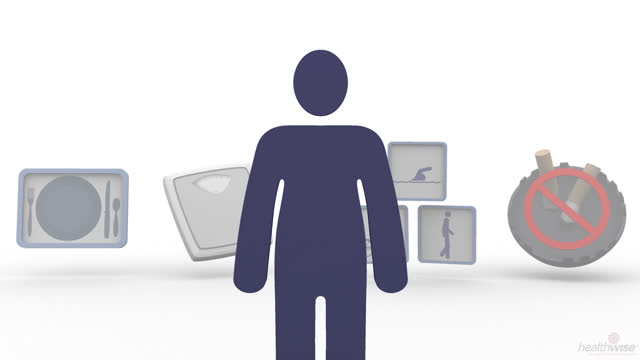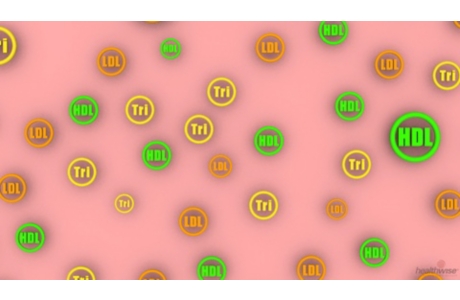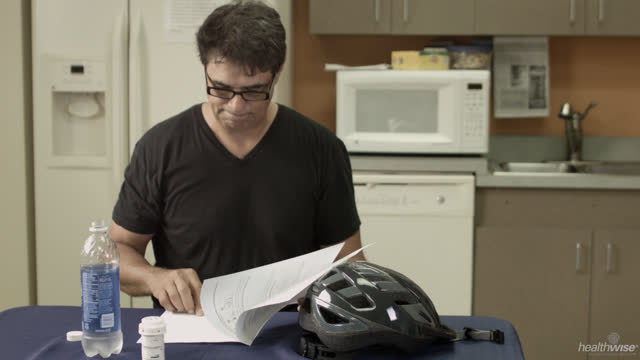High Cholesterol
Topic Overview

What is cholesterol?
Cholesterol is a type of fat (lipid) in your blood. Your cells need cholesterol, and your body makes all it needs. But you also get cholesterol from the food you eat.
If you have too much cholesterol, it starts to build up in your arteries. (Arteries are the blood vessels that carry blood away from the heart.) This is called hardening of the arteries, or atherosclerosis. It is the starting point for some heart and blood flow problems. The buildup can narrow the arteries and make it harder for blood to flow through them. The buildup can also lead to dangerous blood clots and inflammation that can cause heart attacks and strokes.
There are different types of cholesterol.
- LDL is the“bad” cholesterol. It’s the kind that can raise your risk of heart disease, heart attack, and stroke.
- HDL is the “good” cholesterol. It’s the kind that is linked to a lower risk of heart disease, heart attack, and stroke.
Why does cholesterol matter?
Your cholesterol levels can help your doctor find out your risk for having a heart attack or stroke. But it’s not just about your cholesterol. Your doctor uses your cholesterol levels plus other things to calculate your risk. These include:
- Your blood pressure.
- Whether or not you have diabetes.
- Your age, sex, and race.
- Whether or not you smoke.
What affects cholesterol levels?
Many things can affect cholesterol levels, including:
- The foods you eat. Eating too much saturated fat and trans fat can raise your cholesterol.
- Being overweight. This may lower HDL (“good”) cholesterol.
- Being inactive. Not exercising may lower HDL (“good”) cholesterol.
- Age. Cholesterol starts to rise after age 20.
- Family history. If family members have or had high cholesterol, you may also have it.
How is cholesterol tested?
You need a blood test to check your cholesterol.
A cholesterol test, also called a lipid panel, measures all of the fats in your blood, including total, LDL, and HDL cholesterol.
High cholesterol levels don’t make you feel sick. So the blood test is the only way to know your cholesterol levels.
How can you lower your risk of heart attack and stroke?
A heart-healthy lifestyle along with medicines can help lower your risk.
The way you choose to lower your risk will depend on how high your risk for heart attack and stroke is. It will also depend on how you feel about taking medicines. Your doctor can help you know your risk. Your doctor can help you balance the benefits and risks of your treatment options.
Heart-healthy lifestyle changes can help lower risk for everyone. They include:
- Eating a heart-healthy diet that is rich in fruits, vegetables, whole grains, fish, and low-fat or nonfat dairy foods.
- Being active on most, if not all, days of the week.
- Losing weight if you need to, and staying at a healthy weight.
- Not smoking.
Changing old habits may not be easy, but it is very important to help you live a healthier and longer life. Having a plan can help. Start with small steps. For example, commit to adding one fruit or one vegetable a day for a week. Instead of having dessert, take a short walk.
Statin medicine can lower the risk of heart attack and stroke.
- For people whose chance of having a heart attack or stroke is high, taking a statin can be helpful.
- For other people, it’s not as clear if they need to take a statin. You and your doctor will need to look at your overall health and any other risks you have for heart attack and stroke.
Health Tools
Health Tools help you make wise health decisions or take action to improve your health.
- Fitness: Adding More Activity to Your Life
- Healthy Eating: Overcoming Barriers to Change
- Healthy Eating: Starting a Plan for Change
- High Cholesterol: Making Lifestyle Changes
- Quitting Smoking: Coping With Cravings and Withdrawal
- Quitting Smoking: Getting Support
- Quitting Smoking: Preventing Slips or Relapses
- Weight Management: Stop Negative Thoughts
Cause
Cholesterol levels are affected by:
- What you eat. Eating too much saturated fat and trans fat can cause high cholesterol.
- Saturated fat is in foods that come from animals, such as meats, whole milk, butter, and cheese.
- Trans fat is found in fried foods and packaged foods, such as cookies, crackers, and chips.
- Your weight. Being overweight may increase triglycerides and decrease HDL (good cholesterol).
- Your activity level. Lack of physical activity can lower your HDL.
- Your age and gender. After you reach age 20, your cholesterol naturally begins to rise.
- In men, cholesterol generally levels off after age 50.
- In women, it stays fairly low until menopause. Then it rises to about the same level as in men.
- Some diseases. Certain diseases may raise your risk of high cholesterol. These include hypothyroidism, chronic kidney disease, and some types of liver disease.
- Your family history. High cholesterol may run in your family. If family members have or had high cholesterol, you may also have it.
- Cigarette smoking. Smoking can lower your HDL cholesterol.
- Certain medicines. Some medicines can raise triglyceride levels and lower HDL (good) cholesterol levels. These medicines include thiazide diuretics, beta-blockers, estrogen, and corticosteroids.
Symptoms
High cholesterol does not cause symptoms. It is usually found during a blood test that measures cholesterol levels.
Some people with rare lipid disorders may have symptoms such as bumps in the skin, hands, or feet, which are caused by deposits of extra cholesterol and other types of fat.
What Happens
Having high cholesterol can lead to the buildup of plaque in artery walls. This buildup is called atherosclerosis. It can lead to coronary artery disease (CAD), heart attack, stroke or transient ischemic attack (TIA), and peripheral arterial disease.
Atherosclerosis can cause these problems because it:
- Narrows your arteries. When enough plaque builds up, it starts to narrow your arteries. This happens slowly over many years. In time, the plaque can limit blood flow throughout your body, including the heart and brain.
- Hardens your arteries. A healthy artery can widen (dilate) so that more blood can flow through when needed, such as during activity. When hard plaque forms in the walls of an artery, it can make the artery too stiff to widen. This “hardening” of your arteries can also limit blood flow in your body.
- Blocks your arteries. When a blood clot forms around a crack or rupture in the plaque, it can block the artery. This can cause a heart attack or stroke.
For more information, see:
What Increases Your Risk
Some things that increase your risk for high cholesterol are things you can change, but some are not. It’s important to lower your risk as much as possible.
Things you can change include:
- Eating foods high in saturated fat and trans fat.
- Being overweight.
- Not being active every day.
- Smoking.
Each of these things can raise your LDL, lower your HDL, or both.
Things you cannot change include:
- Family history. If high cholesterol runs in your family, you may have it, and it may be harder to treat.
- Age and gender.
For more information, see Cause.
When to Call a Doctor
High cholesterol usually has no symptoms. Sometimes the first sign that you have high cholesterol or other risk factors for heart disease is a heart attack, a stroke, or a transient ischemic attack (TIA). If you have any symptoms of these, call 911 or other emergency services.
Heart attack symptoms include:
- Chest pain or pressure, or a strange feeling in the chest.
- Sweating.
- Shortness of breath.
- Nausea or vomiting.
- Pain, pressure, or a strange feeling in the back, neck, jaw, or upper belly, or in one or both shoulders or arms.
- Lightheadedness or sudden weakness.
- A fast or irregular heartbeat.
After you call 911, the operator may tell you to chew 1 adult-strength or 2 to 4 low-dose aspirin. Wait for an ambulance. Do not try to drive yourself.
Nitroglycerin. If you typically use nitroglycerin to relieve angina and if one dose of nitroglycerin has not relieved your symptoms within 5 minutes, call 911. Do not wait to call for help.
Women’s symptoms. For men and women, the most common symptom is chest pain or pressure. But women are somewhat more likely than men to have other symptoms like shortness of breath, nausea, and back or jaw pain.
Stroke and TIA symptoms include:
- Sudden numbness, tingling, weakness, or loss of movement in your face, arm, or leg, especially on only one side of your body.
- Sudden vision changes.
- Sudden trouble speaking.
- Sudden confusion or trouble understanding simple statements.
- Sudden problems with walking or balance.
- A sudden, severe headache that is different from past headaches.
Who to see
Any of the following doctors, nurses, or specialists can order a cholesterol test and treat high cholesterol:
- Nurse practitioner (NP)
- Physician assistant (PA)
- Family medicine doctor
- Internal medicine doctor
- Cardiologist
- Endocrinologist
A registered dietitian can help you with a diet to lower your cholesterol.
People who have rare lipid disorders, which can be hard to treat, may need to see a specialist, such as a lipidologist or an endocrinologist.
Exams and Tests
A blood test is used to check cholesterol levels.
A cholesterol test measures the level of total cholesterol plus the level of different types of cholesterol and fats in your blood. These include LDL, HDL, and triglycerides.
What do your cholesterol numbers mean?
Your cholesterol levels can help your doctor find out your risk for having a heart attack or stroke. But it’s not just about your cholesterol. Your doctor uses your cholesterol levels plus other things to calculate your risk. These include:
- Your blood pressure.
- Whether or not you have diabetes.
- Your age, sex, and race.
- Whether or not you smoke.
To learn about the test, see the topic Cholesterol and Triglyceride Tests.
For more information about risk, see the topic Heart Attack and Stroke Risk Screening.
Other tests and risk factors
Your doctor may order other tests or talk to you about other risk factors for heart attack and stroke. This helps you and your doctor decide what treatment to lower risk is right for you. You might talk about:
- Your family history of early heart disease. Early heart disease means you have a male family member who was diagnosed before age 55 or a female family member who was diagnosed before age 65.
- An LDL test result of 160 mg/dL or higher.
- Results of tests such as C-reactive protein, coronary calcium scan, or ankle-brachial index.
- Your lifetime risk of heart attack and stroke.
When to have a cholesterol test
How often you need to be checked depends on whether you have other health problems and your risk of heart attack and stroke.
Your child’s doctor may suggest a cholesterol test based on your child’s age, family history, or a physical exam.
For more information, see:
Treatment Overview
The goal of treatment is to reduce your chances of having a heart attack or stroke. The goal is not to lower your cholesterol numbers alone.
The two types of treatment are:
- Lifestyle changes.
- Medicines called statins.
The way you choose to lower your risk will depend on how high your risk for heart attack and stroke is. It will also depend on how you feel about taking medicines. Your doctor can help you know your risk. Your doctor can help you balance the benefits and risks of your treatment options.
Lifestyle changes
Lifestyle changes are always important, even if you take medicines to lower your risk.
Your doctor may suggest that you make one or more of the following changes:
- Eat heart-healthy foods.
- Lose weight if you need to, and stay at a healthy weight.
- Be active on most, if not all, days of the week.
- Don’t smoke.
For more information, see Making Lifestyle Changes.
Medicines
Some people also take medicines called statins, in addition to lifestyle changes, to reduce their risk.
For some people, the chance of having a heart attack or stroke is high. These people may decide to start taking a statin, because statins can reduce this risk.
For other people, it’s not as clear if they need to take a statin. You and your doctor will need to look at your overall health and any other risks you have for heart attack and stroke.
Prevention
A heart-healthy lifestyle can help you prevent heart and blood flow problems, such as heart attacks and strokes.
This lifestyle includes:
- Eating a heart-healthy diet that is rich in fruits, vegetables, whole grains, fish, and low-fat or nonfat dairy foods.
- Being active on most, if not all, days of the week.
- Losing weight if you need to, and staying at a healthy weight.
- Not smoking.
Heart-healthy diets include the DASH diet, the Mediterranean diet and the American Heart Association diet recommendations. This chart compares several heart-healthy diets.
Remember that cholesterol is just one of the things that increase your risk for heart attack and stroke. Controlling other health problems, such as high blood pressure and diabetes, can also help reduce your overall risk.
Making Lifestyle Changes
Lifestyle changes are an important way to stay healthy and lower your risk of a heart attack or a stroke. They are always important, even if you take medicines too.
You can have a healthy lifestyle and still have a cholesterol level that puts you at risk for heart problems or stroke. Cholesterol problems can run in families. And cholesterol goes up as you age, no matter how healthy you are. But healthy habits are worth having because they can help you avoid some of the problems related to cholesterol, like heart disease, peripheral arterial disease, heart attack, and stroke.
What changes do you need to make?
 One Man’s Story: Joe, 61 “The walking was the easy part for me. I get out every evening for a walk. The food part took some thought. Each week, I added a food that was good for me and took something away that was bad for me.”— Joe Read more about how Joe is getting healthy by making one change at a time. |
Eat heart-healthy foods
Making healthy eating habits a part of your daily life is one of the best things you can do to lower your risk. Eating heart-healthy foods can help you manage your weight, cholesterol, and blood pressure. There are a few heart-healthy eating plans you can choose from.
If you have questions about which eating plan to follow, talk to your doctor.
For more information about heart-healthy foods, see:
- High Cholesterol: Healthy Food Choices.
- Foods and Their Effect on Cholesterol.
- Fish, Fish Oil, and Cholesterol.
Stay at a healthy weight
Losing weight if you need to, and staying at a healthy weight, can lower your risk. Losing weight can also help lower your blood pressure.
Get active
Exercise can help you lose weight, lower your blood pressure, and lower your risk. Try to do moderate activity at least 2½ hours a week. Or try to do vigorous activity at least 1¼ hours a week. Getting active has many other benefits too.
Don’t smoke
Quitting smoking may be the best thing you can do to lower your risk of heart attack and stroke.
 One Woman’s Story: Linda, 56 “Terri’s heart attack scared me to death. I decided that this time, I’m doing the whole package. I’m quitting smoking for good.”— Linda |
How do you make lifestyle changes?
 One Man’s Story: Joe, 61 “I’m just not that type of person who can change everything at once.”— Joe |
You can learn simple steps to help you make lifestyle changes, like setting goals. Work on one small goal at a time. Expect slip-ups. Get support from others. Reward yourself for each success. To find out more about making healthy lifestyle changes, see Change a Habit by Setting Goals.
When changing a lifestyle habit, barriers can sometimes get in your way. Figuring out what those barriers are and how you can get around them can help you reach your healthy eating goals.
 One Man’s Story: Joe, 61 “I’ve learned to not beat myself up [when I slip up]. Instead, I refocus on my plan and get right back to eating healthy food. What keeps me going is the results—I’ve lost weight and I feel younger every day.”— Joe |
Medications
Some people need to take medicines to reduce their risk of a heart attack or stroke. Your doctor may recommend that you take medicines called statins.
You and your doctor can work together to decide what treatment is best for you. Your doctor may recommend that you take statins if the benefits outweigh the risks.
Statins are always used along with a plan for a heart-healthy lifestyle, not instead of it.
For more information, see:
 One Man’s Story: Tony, 57 “I don’t mind taking a pill a day. As long as it’s doing me some good. And I no longer have any doubts about that.”— Tony |
Medicine choices
Statins can lower the risk of a heart attack or a stroke.
Your doctor may also talk to you about cholesterol absorption inhibitors or PCSK9-inhibitors. These medicines can also reduce the risk of heart attack and stroke for some people.
Other medicines can improve cholesterol levels, but they have not been proven to lower the risk of a heart attack or a stroke. Your doctor may recommend these medicines if there is a reason you can’t take a statin. These medicines include bile acid sequestrants, fibric acid derivatives, and nicotinic acid (niacin).
Take your medicines properly
Some people find it hard to take their medicines properly. If you do take medicine, it is important to use it the right way.
Some people don’t see why they should take medicines every day when they don’t feel sick. Cholesterol doesn’t make you feel sick. But it’s important to take your statin medicine, because it can lower your risk of heart attack and stroke.
Some side effects are more likely and may be worse when you use higher doses of statins. If you’re having side effects, tell your doctor. You may be able to take a different statin.
For more information, see:
Be sure to tell your doctor about all of the medicines that you take. This includes prescription and over-the-counter medicines, herbs, and supplements. Sometimes they can interact with other medicines and cause problems.
If you have trouble taking your medicine for any reason, talk to your doctor.
Other Treatment
Some plant products can help lower cholesterol. But don’t use them to replace your doctor’s treatment. Research has not proven that they lower the risk of heart attacks and strokes. Whether or not you use such products, be sure to continue your diet, exercise, and prescription medicines.
As with any new form of treatment, make sure to talk with your doctor first. This is especially important if you take statins. Combining statins and some supplements can cause dangerous side effects.
Psyllium
Psyllium is an ingredient in some dietary supplements—Metamucil, for example. It’s a fiber from fleawort and plantago seeds.
Doctors aren’t sure how it helps cholesterol levels. It may make the small intestine absorb less cholesterol, so less of it enters your blood.
Psyllium is approved by the U.S. Food and Drug Administration (FDA). The main side effect is increased bowel movements. Products containing psyllium aren’t recommended to replace foods as a source of fiber.
Sterol or stanol esters
Sterol and stanol esters are used in cholesterol-lowering margarine spreads.
Sterol esters might limit how much cholesterol the small intestine can absorb. These margarines are used along with a heart-healthy diet.
Red yeast rice
Red yeast rice contains a natural form of lovastatin, a statin medicine. This supplement may keep your body from producing too much cholesterol. But this supplement can cause dangerous side effects.
Talk to your doctor before you try red yeast rice. Serious side effects include rhabdomyolysis and hepatitis. Red yeast rice is not regulated by the U.S. Food and Drug Administration (FDA), so you cannot be sure of the amount of red yeast in a supplement. This means you cannot be sure of its dose and safety.
If you take red yeast rice, call your doctor right away if you have a bad reaction to it such as severe muscle pain or symptoms of hepatitis.
Do not take red yeast supplements if you are taking statins. Combining them can cause dangerous side effects.
Other dietary supplements and vitamins
There are some dietary supplements that you may hear about to lower your risk of heart disease, heart attack, and stroke. It is not clear if some vitamins, minerals, and multivitamins can lower risk. But it is clear that some supplements, such as vitamin E and beta-carotene, do not lower risk.footnote 1
Talk with your doctor about the best ways to lower your risk of heart disease, heart attack, and stroke. Tell your doctor if you plan to use dietary supplements or vitamins. Your doctor can make sure they are safe for you.
Related Information
- Heart Attack and Unstable Angina
- Stroke
- Reducing Medication Costs
- Healthy Eating
- Obesity
- Coronary Artery Disease
- Type 1 Diabetes
- Type 2 Diabetes
- Fitness: Getting and Staying Active
- Health Screening: Finding Health Problems Early
- Peripheral Arterial Disease of the Legs
- Dealing With Medicine Side Effects and Interactions
References
Citations
- U.S. Preventive Services Task Force (2014). Vitamin, mineral, and multivitamin supplements for the primary prevention of cardiovascular disease and cancer. U.S. Preventive Services Task Force. http://www.uspreventiveservicestaskforce.org/uspstf/uspsvita.htm. Accessed March 28, 2014.
Other Works Consulted
- Buckley DI, et al. (2009). C-reactive protein as a risk factor for coronary heart disease: A systematic review and meta-analysis for the U.S. Preventive Services Task Force. Annals of Internal Medicine, 151(7): 483–495.
- Eckel RH, et al. (2013). 2013 AHA/ACC guideline on lifestyle management to reduce cardiovascular risk: A report of the American College of Cardiology/American Heart Association Task Force on Practice Guidelines. Circulation. http://circ.ahajournals.org/content/early/2013/11/11/01.cir.0000437740.48606.d1.citation. Accessed December 5, 2013.
- Goff DC Jr, et al. (2013). 2013 ACC/AHA guideline on the assessment of cardiovascular risk: A report of the American College of Cardiology/American Heart Association Task Force on Practice Guidelines. Circulation, published online November 12, 2013. DOI: 10.1161/01.cir.0000437741.48606.98. Accessed November 22, 2013.
- Miller M, et al. (2011). Triglycerides and cardiovascular disease: A scientific statement from the American Heart Association. Circulation, 123(20): 2292–2333.
- Mosca L, et al. (2011). Effectiveness-based guidelines for the prevention of cardiovascular disease in women 2011 update: A guideline from the American Heart Association. Circulation, 123(11): 1243–1262.
- Pearson TA, et al. (2003). Markers of inflammation and cardiovascular disease: American Heart Association and the Centers for Disease Control and Prevention scientific statement. Circulation, 107(3): 499–511.
- Raymond JL, Couch SC (2012). Medical nutrition and therapy for cardiovascular disease. In LK Mahan et al., eds., Krause’s Food and the Nutrition Care Process, 13th ed., pp. 742–781. St Louis: Saunders.
- Red yeast rice (2009). Medical Letter on Drugs and Therapeutics, 51(1320): 71–72.
- Sacks FM, et al. (2006). Soy protein, isoflavones, and cardiovascular health: An American Heart Association science advisory for professionals from the Nutrition Committee. Circulation, 113(7): 1034–1044. Also available online: http://circ.ahajournals.org/cgi/content/full/113/7/1034.
- Stone NJ, et al. (2013). 2013 ACC/AHA guideline on the treatment of blood cholesterol to reduce atherosclerotic cardiovascular risk in adults: A report of the American College of Cardiology/American Heart Association Task Force on Practice Guidelines. Circulation, published online November 12, 2013. DOI: 10.1161/01.cir.0000437738.63853.7a. Accessed November 18, 2013.
- U.S. Preventive Services Task Force (2009). Using nontraditional risk factors in coronary heart disease risk assessment. Available online: http://www.uspreventiveservicestaskforce.org/uspstf/uspscoronaryhd.htm.
Current as of: April 9, 2019
Author: Healthwise Staff
Medical Review:Kathleen Romito MD – Family Medicine & E. Gregory Thompson MD – Internal Medicine & Martin J. Gabica MD – Family Medicine & Elizabeth T. Russo MD – Internal Medicine & Adam Husney MD – Family Medicine
 Atherosclerosis
Atherosclerosis Coronary artery disease
Coronary artery disease Statins: Should You Take Them to Lower Your Risk?
Statins: Should You Take Them to Lower Your Risk? Cholesterol: Choosing a Heart-Healthy Life
Cholesterol: Choosing a Heart-Healthy Life Cholesterol Test: Understanding the Test
Cholesterol Test: Understanding the Test Heart Health: Finding Support for Healthy Changes
Heart Health: Finding Support for Healthy Changes Learning About Risk for Heart Attack and Stroke
Learning About Risk for Heart Attack and Stroke Cholesterol Numbers: What They Mean for Your Health
Cholesterol Numbers: What They Mean for Your Health
This information does not replace the advice of a doctor. Healthwise, Incorporated, disclaims any warranty or liability for your use of this information. Your use of this information means that you agree to the Terms of Use. Learn how we develop our content.

